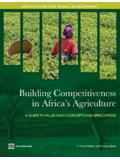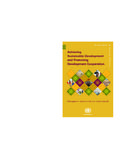Transcription of Economic Development And Structural Change - World Bank
1 1. Economic Development And Structural Change Justin Yifu Lin Senior Vice President and Chief Economist The World bank Lecture at Cairo University Cairo, Egypt November 5, 2009. 2. 1. INTRODUCTION. It is a great honor to address this distinguished audience at such a crucial time in World Economic affairs. Emerging from the worst international financial and Economic crisis since the Great Depression, the global economy appears to be on the path to recovery, pulled up by strong policy response, particularly by emerging countries, mainly in Asia. Nonetheless, the pace of expansion is still very slow, and levels of Economic activity and industrial production remain well below their pre-crisis levels in many countries. Economists and policymakers around the World broadly agree the global recovery is likely to be sluggish. Rebound in the industrialized economies is largely driven by policy stimulus and restocking, with underlying private demand remaining weak.
2 Prospects appear to be much better in emerging economies, though the strength and sustainability of their recovery will also depend on the resurgence of global trade and private financial flows. This is true for Egypt and other countries in the region, where the impact of the crisis was strongly felt but the overall effect has so far been milder than in many other countries and the recovery prospects seems to be better. We need to think differently about what drives Economic growth. The challenges before us are enormous. In many countries, financial systems often remain impaired, excess capacity still is present, unemployment remains on the rise, and there have been setbacks to progress in poverty reduction. Designing and implementing safe exit strategies from the highly expansionary monetary and fiscal policies that have supported demand and helped contain the crisis is a delicate task.
3 At a time where economics as a discipline is being questioned, sometimes for good reasons, it is our responsibility as professional and academic economists to rise to the challenge, to revisit some of the frameworks and approaches that have guided our work, and to propose new ideas where they can make a difference. In my remarks today, I want to focus on moving beyond the crisis, consider medium- and long-term challenges, and reflect on a strategy for achieving sustainable and inclusive growth in developing countries. This is because poverty reduction is still the most challenging Development issue in our time. There were billion people living under $ international poverty line before the crisis. Eighty nine million more people may be trapped in poverty because of the crisis. A sustainable and inclusive growth is essential for poverty reduction globally. In Egypt and the Arab region the growth challenge is even more pressing, given the need to create millions of quality jobs for a rapidly growing labor force, and the historically less than stellar performance in most of the region.
4 2. A BRIEF HISTORY OF Development THINKING. From Adam Smith to the early 20th century, most economists believed that a Laissez faire approach was the best way to achieve sustainable growth. It was assumed that in dynamic growing economies, all decisions about resource allocation are made by Economic agents interacting in markets free of government intervention. The price system determines not only what is produced and how, but also for whom. Households and firms pursuing their own interests would be led, as if by an invisible hand, to do things that are in the 3. interests of others and of society as a whole. This approach to Economic Development assumed that productivity increases in the agriculture and manufacturing sectors are due mainly to incremental refinement of old, traditional technologies for the purposes of exploiting widened markets and specialization. The laissez faire approach basically ignored the possibility of successive introduction of big innovations that create new industries or radically alter methods of production.
5 While this view was challenged by Marxist economists, it was the dominant intellectual framework for the study of growth in all countries for a long time. It took Rosenstein Rodan's well-known 1943 paper1 to bring Development economics into the mainstream. Laissez faire economics suggested that the virtuous circle of Development depended essentially on the interaction between economies of scale at the level of individual firms and the size of the market. Specifically, it assumed that modern methods of production can be made more competitive than traditional ones only if the market is large enough for their productivity edge to compensate for the need to pay higher wages. On the other hand, the size of the market itself depends on the extent to which these modern techniques are adopted. Therefore, if the modernization process can be started on a very large scale, then the process of Economic Development will be self-reinforcing and self- sustaining.
6 If not, countries will be trapped indefinitely in poverty. Rosenstein Rodan's framework sparked a wave of similar ideas from Arthur Lewis, Gunnar Myrdal, Albert Hirschman and others, which came to be known as the structuralist approach to Economic Development . In Latin America for instance, political leaders and social elites were influenced strongly by the deterioration in the terms of trade, the Economic difficulties encountered during the Great Depression in the 1930s and the thesis developed by Raul Prebisch in 1950. They believed that the decline in the terms of trade against the export of primary commodities was secular, which resulted in the transfer of income from resource-intensive developing countries to capital-intensive developed countries. They argued that the way for a developing country to achieve high growth rates was to develop domestic manufacturing industries through a process known as import substitution.
7 Subsequently, these ideas spread beyond Latin America and were adopted elsewhere, including in India and most countries of the Arab World , with Egypt leading the way. Yet, the results were disappointing. Instead of converging to developed countries'. prosperity levels, the income levels in most developing countries stagnated or even deteriorated and the income gap with developed countries widened. This was the case across the developing World , including in Latin America, Africa, South Asia and the Arab countries in the 1960s and 1970s. During this period, import substitution policies intended to promote industrialization by protecting domestic producers from the competition of imports became the source of high tariffs, quotas or restrictions on foreign trade and led to distortions, rent-seeking and Economic inefficiencies. 1. P. Rosenstein Rodan, Problems of Industrialization of Eastern and Southeastern Europe, Economic Journal, vol.
8 111, nos. 210-211, June-September 1943, pp. 202-211. 4. As government-led strategies based on the structuralist teachings failed in many countries, the market-led growth model appeared to triumph and to influence Development thinking. This trend was reinforced by a new revolution in macroeconomics. The prevailing Keynesian macroeconomic model was challenged by the emergence of stagflation in the 1970s, the Latin America debt crisis and the collapse of socialist planning system in the 1980s. Multilateral lending institutions and bilateral lenders especially the United States soon called for a comprehensive set of reforms and advocated a set of policies labeled neoliberal , which follow the canons of rational expectation macroeconomics, later known as the Washington Consensus. Such reforms were pursued according to different degrees of conviction and actual implementation in developing countries.
9 This was the case in Egypt and the Arab countries who have been implementing such reforms at different paces since the 1980s, sometimes hesitantly and at other times more aggressively. Finally, the collapse of socialist economies in the 1980s, which prompted Francis Fukuyama to proclaim the end of History , seemed to mark the complete victory of free market economics over proponents of structuralist state interventions and centrally- planned Economic systems. Most mainstream economists explained at the time that Government intervention in the economy was bound to fail because of the inevitable distortion of the allocation of resources, supply and prices, and the absence of a viable incentive system for Economic agents. They interpreted the Economic collapse in Eastern and Central Europe and Former Soviet Union and the stagnation and frequent crises in Latin America and other developing countries as evidence that the state should refrain from playing a leading role in initiating industrialization.
10 These views fueled the sense that capitalism had triumphed, and neoliberal, Washington Consensus policies came to dominate Development thinking. This school of thought promoted Economic liberalization, privatization, and the implementation of rigorous stabilization programs. Unfortunately, the results of these policies were at best controversial. The story of Economic Development in the past half-century has often been one of disappointments. But there are also a few success stories. The contrast in Economic strategies and performance among developing countries has been intriguing to economists. On the one hand, many countries that followed dominant Economic theories of the time in formulating their policies often failed to Change their Economic structures and narrow the gap with industrial countries. On the other hand, some other countries such as Japan and the four dragons (Korea, Singapore, Taiwan, Hong Kong), started from a low agrarian foundation and were able to quickly climb the industrial ladders and achieve convergence with advanced industrialized countries by the 1980s in terms of Economic structure and income level.
















